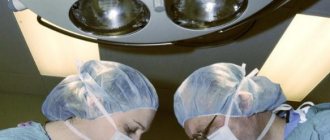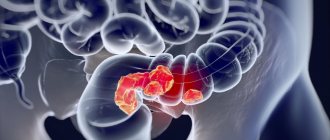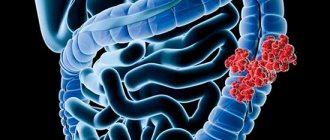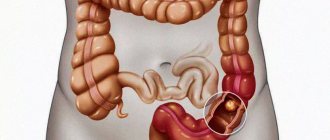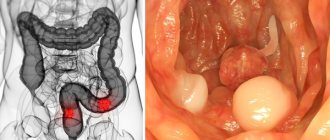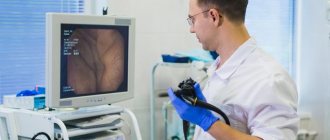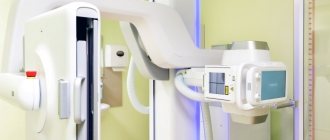Diseases of the small intestine
The final process of food digestion occurs in the small intestine, followed by the absorption of digestive substances, vitamins and minerals. Various diseases of the small intestine manifest themselves in the same way. Most often, our doctor in this case diagnoses “poor absorption syndrome.”
Manifestations of the disease that you may notice in yourself
Diseases of the small intestine usually manifest themselves:
- stool disorders
- rumbling and bloating
- pain.
The most common manifestation is diarrhea 3-6 times a day. Pain occurs in the navel area, sometimes in the epigastric region or the right half of the abdomen. They are most often pulling, aching, bursting and decrease after the passage of gas. There may be intestinal colic: very severe pain with intestinal spasms.
Small intestine: briefly about diseases
Chronic enteritis is inflammation of the small intestine. The causative agents of acute intestinal diseases play a primary role in its occurrence. Enteritis itself is often a post-infectious process. Vascular diseases : abdominal pain that occurs after eating, stool disorders. Timely contact with a professional is very important, since complete blockage of blood vessels may occur. Allergies manifested by intestinal disorders. Celiac enteropathy : deficiency of the enzyme peptidase, which breaks down gluten, a protein ingredient in grain plants; The disease manifests itself as severe diarrhea and weight loss. A rare Whipple's disease , characterized by severe diarrhea, fever, cramping abdominal pain, weight loss, and enlarged lymph nodes. Tumors are mostly benign.
Colon diseases
Colon diseases are:
- ulcerative colitis
- ischemic colitis
- Crohn's disease
- irritable colon
- dolichosigma, megacolon
- diverticulosis
- colon tumors.
Symptoms you may notice
- stool disorders
- stomach ache
- pathological discharge
- rumbling and bloating.
Stool disorders: constipation is more common. Pain in the anus, sides of the abdomen, above the navel or in the epigastric region. The pain is cramping or aching, bursting and is usually not associated with eating. They weaken after bowel movements and the passage of gases.
Large intestine: briefly about diseases
Ulcerative colitis affects the mucous membrane. Dangerous due to the possible development of polyps and tumors. Irritable colon is a complex of intestinal disorders due to disruption of intestinal motility. Crohn's disease : the entire intestine, esophagus, and stomach are affected. With ischemic colitis, inflammation occurs due to narrowing of the vessels that nourish the intestinal walls. Diverticulosis means the presence of multiple diverticula (ending in blind pouch-like protrusions of limited areas of the intestine) and leads to constipation. Dolichosigma - elongation of the sigmoid colon; megacolon - expansion of individual zones or the entire colon. Both diseases cause persistent constipation. Of benign and malignant neoplasms, the latter are more common. Now colon and rectal cancer is the most common malignant tumor.
Specialists
| 5.0 87 reviews | Grigorievskaya Zlata Valerievna Mammologist Experience 18 years Reception from 4500 rub. |
| 5.0 244 reviews | Zagryadsky Evgeniy Alekseevich Mammologist Experience 46 years Doctor of the highest category Reception from 4500 rub. |
Medical center ON CLINIC on Novy Arbat st. Bolshaya Molchanovka, 32, building 1
| 5.0 75 reviews | Brother Alexander Vladimirovich Mammologist Experience 29 years Doctor of the highest category Admission from 4000 rub. |
Diagnostics
Difficulties in diagnosing diseases of the small intestine are explained by the peculiarities of its location. Analysis of the clinical picture, histological, endoscopic, and immunological methods are of decisive importance.
Almost all diseases of the colon are detected by fiber colonoscopy (flexible fiber colonoscopes with fiber optics are used). The examination also includes:
- study using contrast agents
- angiography
- fistulography
- lymphography
- parietography
- ultrasound
- research using radioactive isotopes.
The nature of pain in pathologies of the colon
Weight loss is a sign of colon pathology.
Pain due to pathology of the colon has a unique localization. They are often felt on the side of the abdomen and near the anus.
Less common are unpleasant sensations in the epigastric region, as well as above the navel.
Even in the absence of pain, there will be pain when palpating the area in the iliac region on the right and left.
They become more intense if a person drinks milk or eats a lot of vegetables or coarse cereals. The main character of the pain is aching, accompanied by a feeling of fullness.
If the intestines are freed from gases and feces, the pain subsides. However, immediately before defecation, the pain may become more severe. Sometimes they are cramp-like in nature.
Crohn's disease
Crohn's disease develops rapidly in the body.
The difference between Crohn's disease and ulcerative colitis is the spread of the inflammatory process both to the intestine itself and to neighboring organs (esophagus, stomach).
Not the entire surface is affected, but individual areas. Inflamed areas take turns with healthy areas.
The inflammatory process may not affect the rectum at all. If it starts there, the intestine will undergo pathological narrowing, because not only the mucous membrane itself is affected, but also the submucosal layers.
This is where granuloma cells gather. As the disease progresses, the lymphatic vessels are affected.
Symptoms depend on the development of the disease. If the inflammatory process has affected the right side of the colon, then bloating will be noticeable, diarrhea and pain will appear. If the disease is accompanied by a narrowing of the lumen, then intestinal obstruction is possible.
It can be complete or partial. In any case, the patient will feel sharp pain and nausea, which can quickly develop into vomiting. If the disease affects only the small intestine, then signs characteristic of all diseases of this organ will appear: weight loss, hypovitaminosis, metabolic disorders.
The situation is aggravated by the appearance of purulent fistulas in the anal area. When the duodenum and esophagus are affected, the symptoms are similar to those of a peptic ulcer.
Crohn's disease is a very serious disease. It leads not only to local negative manifestations. Unhappy general symptoms develop quite quickly. This is a feverish state, changes in the joints, eyes, liver. Skin rashes often appear.
Diagnosing Crohn's disease is difficult. It is better to be examined in a hospital setting, since a number of important tests can be carried out there as quickly as possible. When making such a diagnosis, they begin by excluding dairy products and compensating for protein intake through other foods.
Ischemic colitis
Atherosclerosis is the cause of ischemic colitis.
This disease is caused by a pathological narrowing of the vessels responsible for the blood supply to the colon.
The disease begins with the appearance of inflammation in areas that do not receive enough nutrients. Then ulceration begins in these places.
Eventually, the intestinal lumen narrows, leading to obstruction. The main causes of ischemic colitis are serious diseases that result in impaired blood supply:
- diabetes;
- atherosclerosis;
- vein diseases
The listed pathologies lead to ischemic colitis after a long time. Therefore, the main age group of patients is elderly people.
You need to think about the possibility of developing ischemic colitis if after eating (15 minutes later) you feel pain in the left abdomen and there is blood in the stool. As the disease progresses, these two symptoms will become more pronounced.
The pain will intensify, and bleeding will become regular, even clots will appear in the stool.
Treatment of the intestines in women
If you notice abdominal pain, constipation, diarrhea or other symptoms, immediately answer the question: “Do I know the reason why this could happen?” If you haven’t found any reasons (for example, you haven’t eaten fast food for the last three days), then it’s better to contact a good gastroenterologist .
Qualified doctors work, for example, in the ACMD-MEDOX clinic. They will not only find out the exact cause of the disease, conduct a diagnosis using special medical equipment, but also adjust the diet (if the latter really refers to the catalysts that caused the patient to have a medical problem).
Be healthy!
Ulcerative colitis
Ulcerative colitis begins in the rectum.
Among diseases of the colon, ulcerative colitis is perhaps the only pathology leading to sudden weight loss.
With ulcerative colitis, inflammation of the mucous membrane develops. The rectum is most often affected, and this is where the disease begins.
And only then, in the absence of adequate treatment, it quickly spreads further through the large intestine. The disease is chronic, with exacerbations occurring quite often.
Analyzing the causes of ulcerative colitis, researchers came to the conclusion that a hereditary factor is involved. After all, the disease begins in the event of a genetic defect in the immune system.
The disease manifests itself in the appearance of ulceration, erosive surfaces, and foci of hemorrhage directly in the intestine itself. May be accompanied by the formation of polyps and other neoplasms.
Local signs of colitis include bleeding. In this case, patients detect blood in their stool almost constantly. Even outside of an exacerbation, blood may be present. Another important local symptom, which has already been discussed above, is bowel dysfunction.
Constipation, like diarrhea, definitely makes itself felt. However, there is no system. Some suffer from constipation, others from diarrhea, and still others from their alternation.
What is colonic ischemia?
Ischemic colitis (synonymous with ischemic colonopathy)
– inflammatory changes and disruption of the integrity of the colon wall, caused by impaired blood supply to the intestinal wall. The main reason for insufficient supply of arterial blood to the intestinal wall in old age is atherosclerosis of the vessels supplying the colon.
Most often, ischemic disorders affect the left parts of the colon (splenic flexure in 80% of cases), which is due to the peculiarities of the blood supply to the intestine in this area. The rectum, which has an abundant blood supply, is extremely rarely susceptible to ischemic lesions. The large intestine normally has less blood supply than the small intestine and, accordingly, is more sensitive to ischemia.
In addition, it has been shown that the physiological motor activity of the colon is accompanied by a decrease in blood flow, while, for example, the blood supply to the small intestine increases during digestion and peristaltic activity.
Thus, the combination of a normally reduced blood supply and decreased blood flow during functional activity
distinguishes the colon as a unique blood flow organ.
Reduced blood flow in the colon has also been observed as a result of exposure to emotional stress
.
An additional factor
constipation
that increases intestinal ischemia in the elderly . Chronic constipation (straining) increases intraintestinal pressure and reduces blood flow in the colon wall.
The most common form of colon ischemia is reversible (transient) violations of the integrity of the intestinal wall, occurring in 60% of cases. With the progression of atherosclerosis and a critical disruption of the blood supply to the intestines, tissue necrosis occurs with the development of severe conditions requiring emergency surgical treatment.
With ischemia of the colon, the mucous membrane is primarily affected, since it is especially sensitive to hypoxic conditions.
Apparently, this is due to the high activity of metabolic processes occurring in it. As the degree of ischemia increases, damage spreads from the mucous membrane towards the submucosal and muscular layers. In severe forms, deep damage occurs, often resulting in perforation or stricture formation.
Colitis after antibiotic therapy
Lincomycin causes the development of specific colitis.
Long-term treatment with antibiotics causes the development of specific colitis. Most often, the disease begins after taking lincomycin, tetracycline.
It was noted that the likelihood of the disease increases in those who took medications orally and combined them with other medications.
For example, with laxatives. Due to the entry into the intestines of substances dangerous to microorganisms, the beneficial microflora is massively destroyed and washed out (as is the case with laxatives).
In such conditions, clostridia begins to actively reproduce. This is a dangerous microbe, the secretions of which have a detrimental effect on the condition of the intestinal wall. Its toxic secretions lead to the destruction of the intestinal mucosa and can even cause perforation.
The hallmark of this disease is considered to be plaques that can be found everywhere on the mucous membrane. They are called membranes in another way, and the colitis itself is called pseudomembranous.
Depending on the severity of the patient’s condition, 3 stages of the disease are distinguished: mild, moderate, severe.
- The mild form is manifested only by diarrhea. It continues as long as antibiotics enter the body. After completing the course of antibiotic therapy, the symptoms disappear.
- Moderate severity is characterized by the continuation of symptoms even after discontinuation of antibiotics. Frequent watery diarrhea is accompanied by pain before defecation. Signs of intoxication gradually increase. There is a feeling of weakness, nausea, which can develop into vomiting.
- Severe form. Signs characteristic of a moderately severe condition are aggravated. Heart problems appear: the pulse quickens, and the pressure can drop significantly.
In order not to bring the condition to a critical level, it is better to stop taking them if diarrhea occurs during antibiotic treatment and consult a doctor. This will prevent the development of the disease.
If it is necessary to continue treatment, drugs that kill clostridia are prescribed. For example, metronidazole, vancomycin. If the situation cannot be normalized, the patient is hospitalized.
